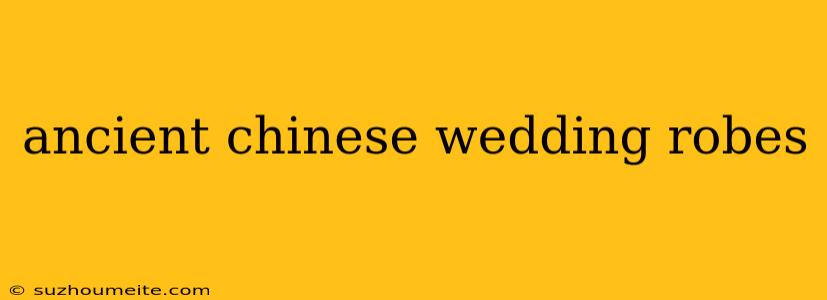Ancient Chinese Wedding Robes: A Tapestry of Tradition and Symbolism
Ancient Chinese weddings were grand affairs, filled with intricate rituals and elaborate garments. Among these, the wedding robes held a special significance, acting as more than just clothing, but as a reflection of social status, family lineage, and auspicious blessings for the newly married couple.
The Significance of Red
Red, a vibrant and auspicious color in Chinese culture, was the dominant hue for wedding robes. It symbolized good fortune, happiness, and prosperity, warding off evil spirits and welcoming a new beginning.
The Elaborate Designs
Ancient Chinese wedding robes were meticulously crafted, often featuring intricate patterns and symbols with deep meanings.
1. The Dragon and Phoenix: The most prominent motif was the dragon and phoenix. The dragon, a powerful symbol of the groom, represented strength, nobility, and imperial authority. The phoenix, symbolizing the bride, embodied grace, beauty, and virtue. Together, they embodied the union of Yin and Yang, signifying a harmonious and prosperous marriage.
2. Mandarin Ducks: Mandarin ducks, known for their lifelong monogamy, were another frequent motif, representing marital fidelity and lasting love.
3. Flowers and Vines: Floral patterns, like the peony (symbolizing love and prosperity), the lotus (representing purity and enlightenment), and the plum blossom (signifying resilience and perseverance), added beauty and auspiciousness to the robes.
4. Swirling Clouds and Mountains: These patterns symbolized longevity and the enduring strength of the marriage.
5. Silk and Brocade: The fabrics used were equally significant. Silk, a luxurious material, symbolized wealth and status. Brocade, with its intricate woven designs, reflected the couple's refined taste and social standing.
The Evolution of Wedding Robes
Over the centuries, the styles and designs of Chinese wedding robes evolved.
- Han Dynasty (206 BC – 220 AD): Robes were simpler, featuring minimal embroidery and designs.
- Tang Dynasty (618 – 907 AD): Robes became more elaborate, incorporating intricate patterns and vibrant colors.
- Ming Dynasty (1368 – 1644 AD): Robes reached their peak of opulence, featuring elaborate embroidery, gold thread, and intricate symbolism.
Modern Echoes
While traditional Chinese wedding robes are rarely worn today, their influence can still be seen in modern wedding attire. The use of red, the inclusion of dragon and phoenix motifs, and the emphasis on symbolism continue to be incorporated into contemporary wedding gowns and attire, ensuring the enduring legacy of these ancient garments.
